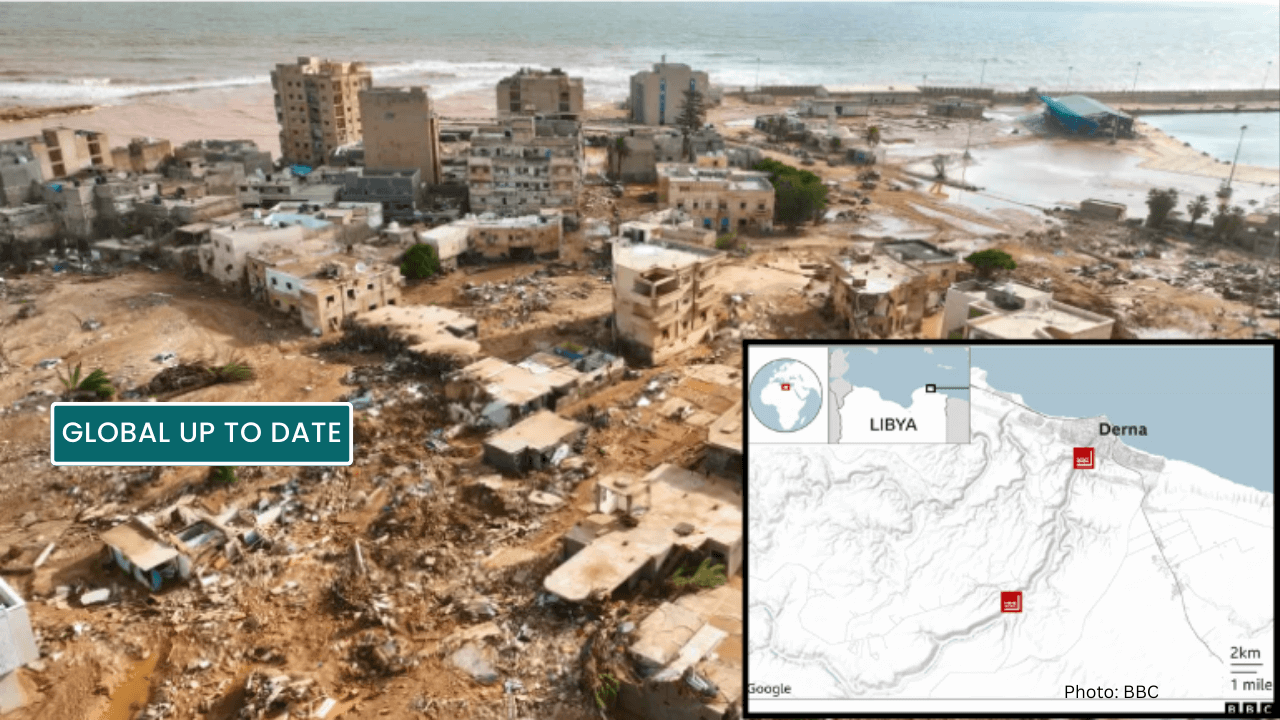Behind The Libya Floods Tragedy: A Culprit Known to All but Acknowledged by Few
Kazi Israt Jahan | 24 September 2023
Just when the world was already weeping in the devastation of the Morocco earthquake tragedy, another tragedy struck in one of their neighboring countries, Libya. It has become like a race of rising death toll in both countries, a race of devastation. On September 11th,thousands of lives washed away to the sea in a 7-meter-high wave of gushing down water in the city of Derna. Breaking down of two dams in the outskirts of the city Derna has caused this apocalyptic flash flood causing over ten thousand deaths according to the estimation of Libyan Red Crescent as the missing peoples list cross another ten thousand but the chances of finding them alive are thin.
It all started with the torrential rainfall caused from the Mediterranean storm Daniel. A storm of the strength of a hurricane hit the Mediterranean countries pouring down a heavy rainfall equivalent of the annual rainfall of the countries in one day. Libya, a country typically of desert weather, had too little experience of such heavy rain, was caught off guard in the face of the storm. Two dams of Wadi Derna, a seasonal river that typically stays dry for most of the year, were unable to withhold such high water accumulated from the rainfall and collapsed. Seven-meter-high Violent wave of water came down and wiped out the port city Derna in the moment’s notice. Bodies of people swept away to the sea, buildings and structures destroyed leaving 25 percent of the city in ruins.
So, what caused so much loss of lives in Libya? One of the obvious causes are the poor infrastructures of the city. Libya, a country with a weak economy, where a lot of people were already in need of support from the international community before the flood. Why would an oil rich country have such a poor economy, is a talk of another tale. Storm Daniel, that also down poured in parts of Turkey, Bulgaria and Greece, caused so much destruction in Libya because of the poor state of the dams and a weak governance who failed to warn and guide people despite having the warning of the Libya’s National Meteorological Center. Water swelled up behind the dams and yet they didn’t issue any notice to evacuate, even the curfew was lifted on September 11th.
But was that reason all behind the tragic incident? People are now asking questions about how was it normal to have such in intense storm emerge and cause rainfall in typically dry countries. The answers all point toward the one direction, Climate Change. Yes, as obvious as it seems, a time is approaching when no problem of the world will not be caused by that.
Experts say storms like Daniel are the rare ones that will be a thing called new normal in our generation. Mediterranean storms of the caliber of hurricanes, generally known as Medicanes happens only once to three times annually, and mostly in the north and west Mediterranean region like Greece. But the Medicanes are most likely to get stronger and fiercer in the gradually warming waters of the Mediterranean Sea and also affect the eastern and southern Mediterranean shores of the African continent, according to the United Nations’ IPCC’s Sixth Assessment Report. And the prediction is already realized in front our eyes by the storm Daniel.
Daniel caused flooding in Greece, Turkey and Bulgaria and killed more than 20 people. This storm causing flood in Greece is a one in 250-year event according to the researchers who also say that, this is going to be 10 times more likely to occur and 40 percent more intense by the fast-changing climate.
Extending heat waves and weakening jet streams are causing the atmosphere to become unbalanced. Warmer seas only help the cyclones to take up more moisture and warmer air can hold more moisture, ultimately causing more intense cyclone downpours. Lands already dried up by the warming naturally gets less able to absorb water, finally gets tremendous amount of water pouring down and the floods get worsened. Researchers are getting to the bottom of this matter by studying exactly how climate change influenced Daniel. As it is not too hard to see how it affected the storm because of the record-breaking temperature warming the Mediterranean region reaching a record 28.7 degrees Celsius, 2-3 degrees warmer than usual only three months prior the floods.
The harms caused by the same storm are so disproportionate in the countries Greece and Libya shows that, only the weak and unprepared falls victim to the climate change which is actually happening by the carbon emissions mostly done by the countries now called “Global North”. Of course, they share their burdens with providing the “Climate Funds” to the global south but the lives already lost remains beyond compensation. But how much further can the global south rely on their climate funds for the adaptation and mitigation of climate change? According to the experts, the time is already approaching when they will need to divert the climate funds to themselves as they will also face the losses due to climate change and the fund is always limited.
Kazi Israt Jahan is a Research Intern at CGS
